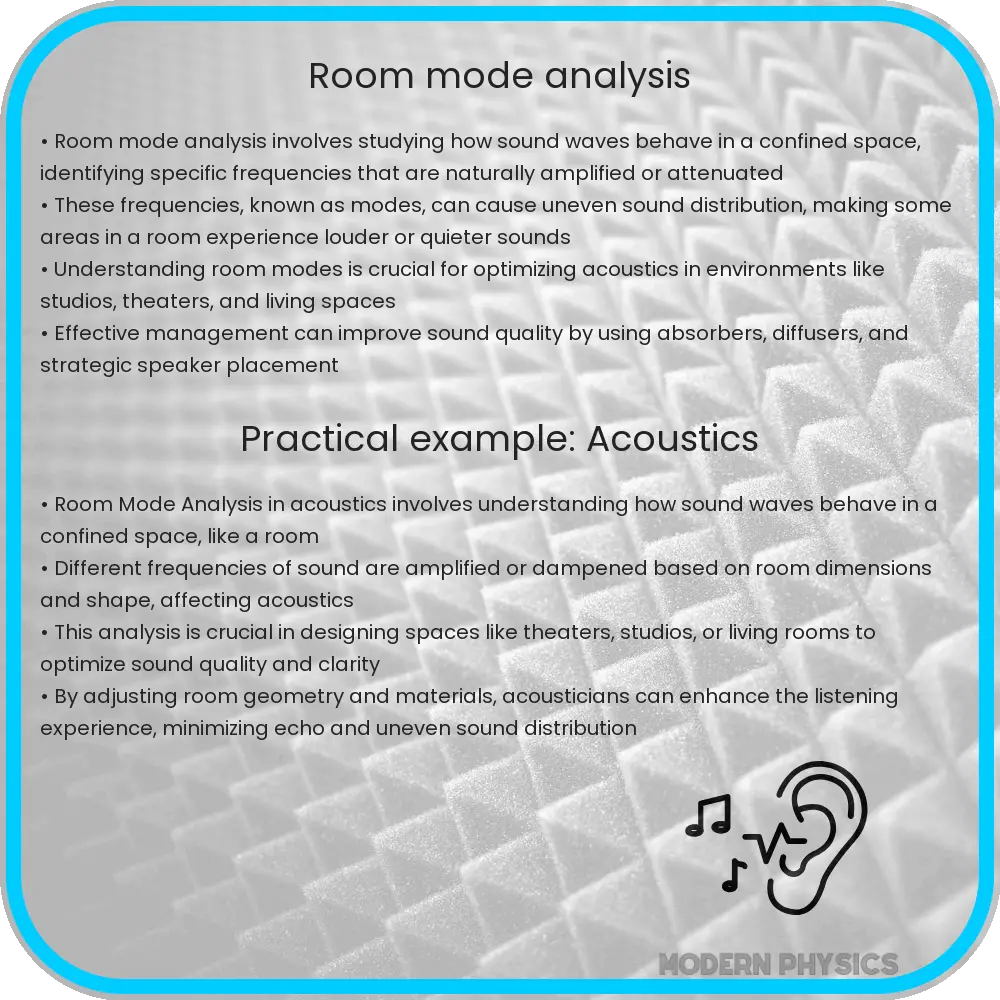Learn how room modes impact sound quality in enclosed spaces by influencing audio precision, clarity, and balance.

Understanding Room Mode Analysis for Acoustic Precision, Clarity, and Balance
When setting up an audio space, whether it’s a recording studio, a home theater, or an audiophile’s listening room, one of the most critical factors influencing sound quality is how sound waves interact with the room itself. This interaction is defined largely by the room’s dimensions and results in what are known as ‘room modes.’ Understanding and managing these modes are key to achieving the desired acoustic precision, clarity, and balance in any room.
Room modes are essentially the natural resonances that occur within a confined space due to the boundaries of the room—walls, floor, and ceiling. These modes can significantly color the sound by amplifying certain frequencies while diminishing others, leading to inaccuracies in sound reproduction.
Introduction to Room Modes
Room modes stem from the reflection and interference of sound waves bouncing off the surface of the room. They are categorized into three types:
- Axial modes: Occur between two parallel surfaces, such as two opposite walls. These modes are the simplest type and usually the strongest and most problematic.
- Tangential modes: Involve four surfaces and are generally less intense than axial modes.
- Oblique modes: Involve all six surfaces of a room and are the least intense.
The frequencies at which these modes occur are dependent on the dimensions of the room and can be calculated using the formula:
fn,m,l = (c/2) * sqrt((n/L)2 + (m/W)2 + (l/H)2)
Where:
- fn,m,l is the frequency of the mode,
- c is the speed of sound (approximately 343 meters per second at room temperature),
- n, m, l are the mode numbers along each dimension (length, width, height respectively),
- L, W, H are the dimensions of the room (length, width, height respectively).
This equation illustrates that the lower modes (where n, m, or l is low) occur at lower frequencies and are more spaced apart, while higher modes crowd closer together as frequency increases.
Impact of Room Modes on Sound Quality
Room modes can greatly affect the acoustic properties of a room. At modal frequencies, waves reinforce each other to create peaks (areas of high pressure) and nulls (areas of low pressure) at specific locations within the room. This results in an uneven frequency response: certain notes may boom or resonate excessively, while others may drop out or seem much quieter. This problem is particularly noticeable in smaller rooms, where the lowest modes can be widely spaced in frequency, resulting in significant peaks and dips in the room’s frequency response curve.
For audio professionals and enthusiasts, understanding room modes is essential for optimizing the acoustic environment of a space. Effective room mode analysis and treatment ensure that sound reproduction is as true to the original recording as possible, free from the coloration imposed by the room’s dimensions and construction. Properly managing room modes involves several strategies, including room design considerations, speaker placement, and acoustic treatment.
Strategies for Managing Room Modes
Effective management of room modes starts with strategic room and furniture layout. This can include orienting the room setup diagonally to disrupt modal patterns, or positioning speakers and listeners at optimal locations. Ideally, speakers should not be placed symmetrically in the corner or center of walls, as these placements often exacerbate mode effects.
Beyond physical layout adjustments, acoustic treatment is crucial. This includes using absorbers and diffusers specifically designed to tackle problematic frequencies. Absorbers help to dampen the modes, particularly the lower frequency modes, by absorbing sound energy, while diffusers scatter the sound, reducing focal points of intensity.
Another practical approach involves using electronic solutions such as digital signal processors (DSPs). These devices can help equalize room response by actively adjusting the audio output based on the acoustic characteristics detected in the room.
The Role of Simulation in Room Mode Analysis
With advancements in technology, simulation software has become an invaluable tool for acousticians and audio engineers. These programs allow for the virtual modeling of a room’s acoustic response, enabling professionals to predict and visualize room mode patterns and their effects on sound quality. This preemptive analysis helps in making informed decisions about room design and treatment strategies before physical modifications are made.
Simulation not only saves time and resources but also provides a platform for experimenting with different configurations and treatments to achieve the best possible acoustics for a given space.
Conclusion
Understanding and managing room modes is crucial for creating an optimal listening environment. Whether it’s in a professional recording studio, a home theater, or an audiophile’s listening room, the clarity and balance of sound can be significantly enhanced by addressing the acoustic anomalies caused by room modes. By applying a combination of room design, acoustic treatment, and digital technology, one can effectively mitigate the adverse effects of these modes, leading to a more accurate and enjoyable auditory experience. Remember, each space is unique, and the approach to managing its acoustics should be tailored to its specific challenges and requirements.
Ultimately, the goal is to transform any auditory environment into one that best replicates the true sound as it was intended to be heard, free from distortions and resonances imposed by the space itself.
